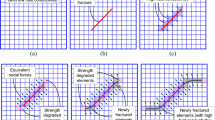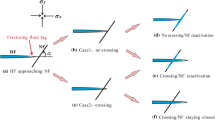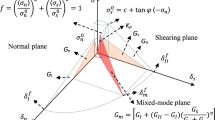Abstract
Hydraulic fracturing has been proven to be the most efficient way to improve the permeability of coal seams. In this work, the hydraulic fracture propagation in an underground coal mine was numerically investigated. A new numerical approach was developed based on the equivalent continuum methodology to model the hydro-mechanical behavior of multiple fractures in three dimensions. It was solved using a hybrid combination of the embedded element method (EEM) and the finite volume method (FVM) using an iterative coupling schema. The FVM was employed to calculate the pressure field, while the EEM was used to track the displacement discontinuity caused by fractures. A fracture constitutive model was implemented to describe the aperture variation, shear slippage, and shear dilation for both contact and open fractures, as well as for contact and open criteria. To verify the developed model, two benchmark examples were presented. Then, the developed model was used to numerically investigate hydraulic fracture propagation in Datong underground coal mine in Songzao in Chongqing. According to the numerical study, it was found that (1) a fracture network created by a hydraulic fracturing operation in a coal mine is more complex than the ideal cross-cutting-shape, H-shape, T-shape, and Z-shape patterns; (2) the orientation of the minimum principal stress controlled the main propagation direction; (3) the complexity of the fracture pattern is controlled by the geological structure, the in situ stress and the injection rate.















Similar content being viewed by others
Abbreviations
- A :
-
Connection area of the two neighbor elements
- b :
-
Fracture width
- B :
-
Volumetric force vector
- C :
-
Cohesion
- D :
-
Hook tensor expressed in matrix form
- E :
-
Young’s modulus
- f :
-
Failure function
- F :
-
Force vector
- G :
-
Shear modulus
- k f :
-
Fracture permeability
- k ij,f :
-
Permeability tensor
- k n :
-
Normal stiffness
- k s :
-
Shear stiffness
- L :
-
Fracture length
- m :
-
Nodal mass
- P :
-
Fluid pressure
- q :
-
Flow rate
- Q s :
-
Source term
- S :
-
Fracture spacing
- t n, t s, t t :
-
Normal and the tangential traction
- t n0, t s0, t t0 :
-
Cohesive strengths
- T :
-
Internal force vector calculated using the integral of stresses over element volume
- u :
-
Displacement vector
- v :
-
Velocity vector
- V :
-
Volume
- w :
-
Fracture aperture
- α :
-
Damping coefficient
- γ:
-
Correction factor resulting from fracture roughness
- δ ij :
-
Kronecker tensor
- µ :
-
Fluid dynamic viscosity
- ρ m :
-
Rock density
- σ :
-
Cauchy stress tensor
- υ :
-
Poisson ratio
- φ :
-
Dilation angle
- ϕ :
-
Frictional angle
- Δε :
-
Strain increment tensor
References
Abass HH, Van Domelen ML, EI Rabaa WM (1990) Experimental observations of hydraulic fracture propagation through coal blocks. In: SPE eastern Regional Meeting. Society of Petroleum Engineers
Anderson GD (1981) Effects of friction on hydraulic fracture growth near unbonded interfaces in rocks. Soc Pet Eng J 21(1):21–29
Asadi R, Ataie-Ashtiani B, Simmons CT (2014) Finite volume coupling strategies for the solution of a biot consolidation model. Comput Geotech 55:494–505
Bandis SC, Lumsden AC, Barton NR (1983) Fundamentals of rock joint deformation. Int J Rock Mech Min Sci Geomech Abstr 20(6):249–268
Bonet J, Burton AJ (1998) A simple averaged nodal pressure tetrahedral element for nearly incompressible dynamic explicit applications. Commun Numer Methods Eng 14:437–449
Bunger AP, Detournay E, Garagash DI (2005) Toughness-dominated hydraulic fracture with leak-off. Int J Fract 134:175–190
Cai X, Deam RH, Wheeler MF, Liu R (2016) Coupled geomechanical and reservoir modeling on parallel computers. In: SPE reservoir simulation symposium held in New York, USA
Camcho GT, Ortiz M (1996) Computational modelling of impact damage in brittle materials. Int J Solids Struct 33(20):2899–2938
Chen ZR, Jeffrey RG, Zhang X (2015) Numerical modeling of three-dimensional T-shaped hydraulic fractures in coal seams using a cohesive zone finite element model. Hydraul Fract J 2:2
Daneshy AA (1978) Hydraulic fracture propagation in layered formations. Soc Pet Eng J 18:33–41
Dershowitz WS, Cottrell MG, Lim DH, Doe TW (2010) A discrete fracture network approach for evaluation of hydraulic fracture stimulation of naturally fractured reservoirs. In: Proceedings of the 44th US rock mechanics symposium held in Salt Lake City, June 27–30
FLAC3D (2008) Manual, version 4.0. ITASCA Consulting Group, Inc, Minneapolis
Fossum AF (1985) Technical note: effective elastic properties for a randomly jointed rock mass. Int J Rock Mech Min Sci Geomech Abstr 22(6):467–470
Fu PC, Johnson SM, Hao Y, Carrigan CR (2011) Fully coupled geomechanics and discrete flow network modeling of hydraulic fracturing for geothermal applications. In: Proceedings of the 36th workshop on geothermal reservoir engineering, held in Stanford, USA, January 31–February 2
Gerrard CM (1982a) Elastic models of rock masses having one, two and three sets of joints. Int J Rock Mech Min Sci Geomech Abstr 19:15–23
Gerrard CM (1982b) Equivalent elastic moduli of a rock mass consisting of orthorhombic layers. Int J Rock Mech Min Sci Geomech Abstr 19:9–14
Goodman RE, Taylor RL, Brekke T (1968) A model for the mechanics of jointed rock. J Soil Mech Found Div Proc Am Soc Civ Eng 94(SM3):637–659
Guo JC, Zhao X, Zhu HY, Zhang XD, Pan R (2015) Numerical simulation of interaction of hydraulic fracture and natural fracture based on the cohesive zone finite element method. J Nat Gas Sci Eng 25:180–188
Hou ZM, Zhou L, Kracke T (2013) Modelling of seismic events induced by reservoir stimulation in an enhanced geothermal system and a suggestion to reduce the deformation energy release. In: Proceedings of 1st international conference on rock dynamics and applications. RocDyn-1, 161–175, held in Lausanne, Switzerland
Huang BX, Liu JW (2017) Experimental investigation of the effect of bedding planes on hydraulic fracturing under true triaxial stress. Rock Mech Rock Eng 50:2627–2643
Jeffrey RG, Zhang X (2008) Hydraulic fracture growth in coal. In: Potvin Y, Carter J, Dyskin A, Jeffrey R (eds) Proceedings of the first southern hemisphere international rock mechanics symposium. Australian Centre for Geomechanics, Perth, pp 369–379
JHa B, Juanes R (2007) A locally conservative finite element framework for the simulation of coupled flow and reservoir geomechanics. Acta Geotech 2:139–153
Jiang TT, Zhang JH, Wu H (2016) Experimental and numerical study on hydraulic fracture propagation in coalbed methane reservoir. J Nat Gas Sci Eng 35:455–467
Kim J, Tchelepi HA, Juanes R (2011) Stability, accuracy and efficiency of sequential methods for coupled flow and geomechanics. SPE J 16:02
Kim J, Sonnenthal EL, Rutqvist J (2012) Formulation and sequential numerical algorithms of coupled fluid/heat flow and geomechanics for multiple porosity materials. Int J Numer Methods Eng 92:425–456
Kresse O, Weng XW, Gu HR, Wu RT (2013) Numerical modeling of hydraulic fractures interaction in complex naturally fractured formations. Rock Mech Rock Eng 46:555–568
Li LC, Tang CA, Tham LG, Yang TH, Wang SH (2005) Simulation of multiple hydraulic fracturing in non-uniform pore pressure field. Adv Mater Res 9:163–172
Li SB, Li X, Zhang DX (2016) A fully coupled thermo-hydro-mechanical, three-dimensional model for hydraulic stimulation treatments. J Nat Gas Sci Eng 34:64–84
Liu JC, Wang HT, Yuan ZG, Fan XG (2011) Experimental study of pre-splitting blasting enhancing pre-drainage rate of low permeability heading face. Proc Eng 26:818–823
Liu Y, Xia BW, Liu XT (2015) A novel method of orienting hydraulic fractures in coal mines and its mechanism of intensified conduction. J Nat Gas Sci Eng 27:190–199
Lu YY, Liu Y, Li XH, Kang Y (2010) A new method of drilling long boreholes in low permeability coal by improving its permeability. Int J Coal Geol 84:94–102
McClure MW, Babazadeh M, Shiozawa S (2015) Fully coupled hydromechanical simulation of hydraulic fracturing in 3D discrete-fracture networks. In: Proceedings of the SPE hydraulic fracturing technology conference, held in Woodlands, Texas, USA, 3–5 February
Meyer BR, Bazan LW (2011) A discrete fracture network model for hydraulically induced fractures-theory, parametric and case studies. In: SPE hydraulic fracturing technology conference, held in Texas, USA, 24–26 January
Nassir M, Settar A (2013) Prediction of stimulated reservoir volume and optimization of fracturing in tight gas and shale with a fully elasto-plastic coupled geomechanical model. In: Proceeding of the SPE hydraulic fracturing technology, held in Woodlands, USA, 4–6 February
Oliver J (1995) Continuum modelling of strong discontinuities in solid mechanics using damage models. Comput Mech 17:49–61
Oliver J (1996) Modelling strong discontinuities in solid mechanics via strain softening constitutive equations. Part 2: numerical simulation. Int J Numer Methods Eng 39:3601–3623
Peirce AP, Siebrits E (2001) The scaled flexibility matrix method for the efficient solution of boundary value problems in 2D and 3D layered elastic media. Comput Methods Appl Mech Eng 190(45):5935–5956
Peirce AP, Siebrits E (2002) Uniform asymptotic approximations for accurate modeling of cracks in layered elastic media. Int Int J Fract 110:205–239
Ren XY, Zhou L, Li HL, Lu YY (2019) A three-dimensional numerical investigation of the propagation path of a two-cluster fracture in horizontal wells. J Pet Sci Eng 173:1222–1235
Réthoré J, de Borst R, Abellan MA (2007) A two-scale approach for fluid flow in fractured porous media. Int J Numer Methods Eng 7:780–800
Rutqvist J, Wu YS, Tsang CF, Bodvarsson G (2002) A modeling approach for analysis of coupled multiphase fluid flow, heat transfer, and deformation in fractured porous rock. Int J Rock Mech Min Sci 39:429–442
Tan P, Jin Y, Han K, Zheng XJ, Hou B, Gao J, Chen M (2017) Vertical propagation behavior of hydraulic fractures in coal measure strata based on true triaxial experiment. J Pet Sci Eng 158:398–407
Tang C, Tham L, Lee P, Yang T, Li L (2002) Coupled analysis of flow, stress and damage (FSD) in rock failure. Int J Rock Mech Min Sci 39:477–489
Teufel LW, Clark JA (1984) Hydraulic fracture propagation in layered rock: experimental studies of fracture containment. Soc Pet Eng J 24(1):19–32
Wan T, Hu WR, Elsworth D, Zhou W, Zhou WB, Zhao XY (2017) The effect of natural fractures on hydraulic fracturing propagation in coal seams. J Pet Sci Eng 150:180–190
Watanabe N, Wang W, Taron J, Görke UJ, Kolditz O (2012) Lower dimensional interface elements with local enrichment: application to coupled hydro-mechanical problems in discretely fractured porous media. Int J Numer Methods Eng 90:1010–1034
Witherspoon JSY, Wang KI, Gale JE (1980) Validity of cubic law for fluid-flow in a deformable rock fracture. Water Resour Res 16:1016–1024
Wu CF, Zhang XY, Wang M, Zhou LG, Jiang W (2018) Physical simulation study on the hydraulic fracture propagation of coalbed methane well. J Appl Geophys 150:244–253
Zhang X, Jeffrey RG (2006) Numerical studies on crack problems in three-layered elastic media using an image method. Int J Fract 139(3–4):477–493
Zhou L, Hou MZ, Gou Y, Li MT (2014) Numerical investigation of a low-efficient hydraulic fracturing operation in a tight gas reservoir in the North German Basin. J Pet Sci Eng 120:119–129
Zhou L, Su XP, Hou ZM, LU YY, Gou Y (2016) Numerical investigation of the hydromechanical response of a natural fracture during fluid injection using an efficient sequential coupling model. Environ Earth Sci 75:1263
Acknowledgements
The work presented in this paper is funded by the National Natural Science Foundation of China (no. 51774056), the National Science Fund for Distinguished Young Scholars of China (no. 51625401), the Chongqing Research Program of Basic Research and Frontier Technology (no. cstc2017jcyjB0252), and the Program for Changjiang Scholars and Innovative Research Team in University (IRT_17R112). Dr. Zhou is the principle developer of the 3D numerical model. Mr. Su worked the multiple fracture constitutive model into the new numerical model. Prof. Lu gave informative discussion in the numerical application. Dr. Ge carried out the numerical application. Dr. Zhang gave the idea to use EEM to describe the mechanical behavior of multiple fractures. Mr. Shen conducted part of the implementation work. We would like to thank LetPub (http://www.letpub.com) for providing linguistic assistance during the preparation of this manuscript.
Author information
Authors and Affiliations
Corresponding author
Additional information
Publisher’s Note
Springer Nature remains neutral with regard to jurisdictional claims in published maps and institutional affiliations.
Rights and permissions
About this article
Cite this article
Zhou, L., Su, X., Lu, Y. et al. A New Three-Dimensional Numerical Model Based on the Equivalent Continuum Method to Simulate Hydraulic Fracture Propagation in an Underground Coal Mine. Rock Mech Rock Eng 52, 2871–2887 (2019). https://doi.org/10.1007/s00603-018-1684-x
Received:
Accepted:
Published:
Issue Date:
DOI: https://doi.org/10.1007/s00603-018-1684-x




